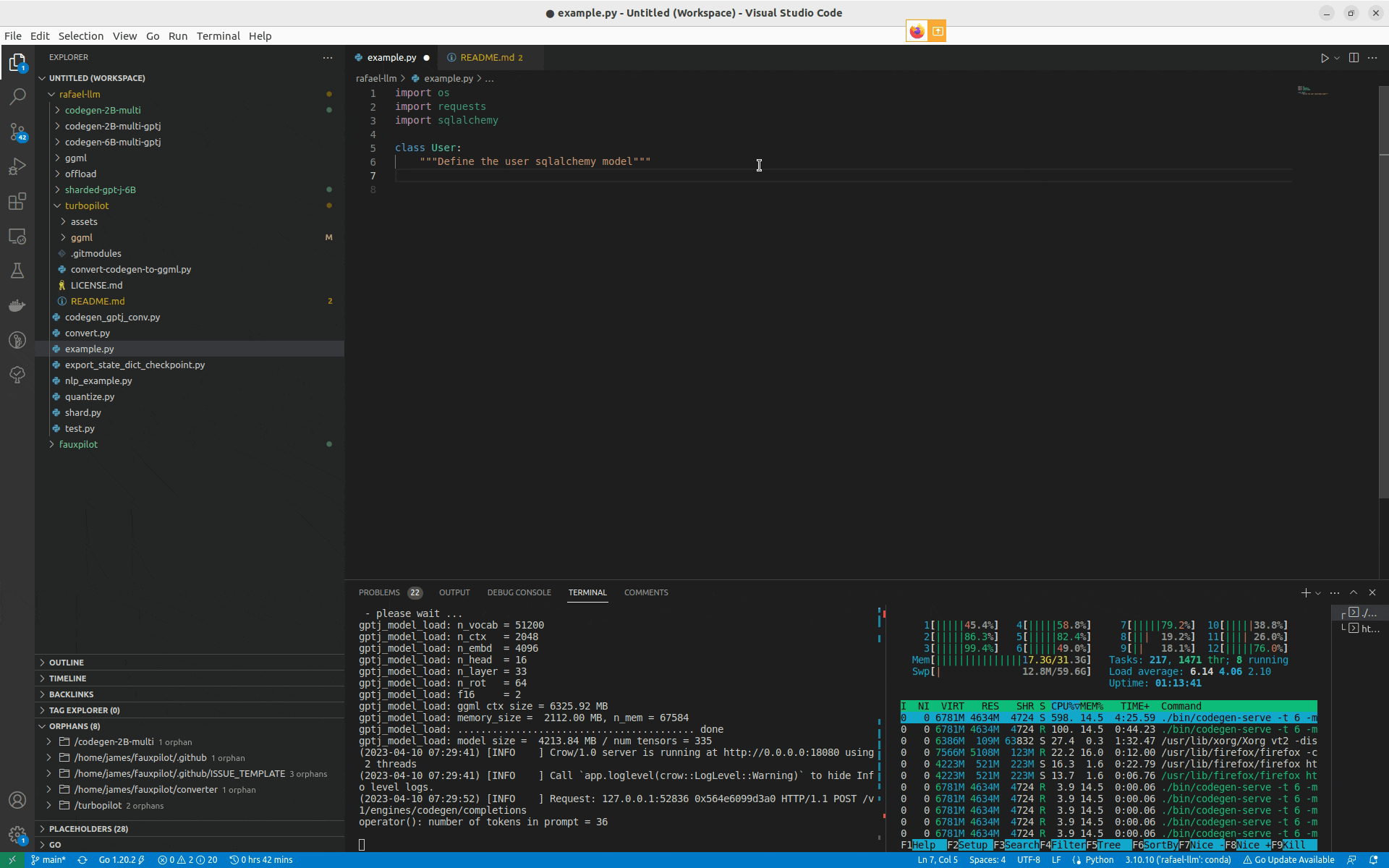| .github/workflows | ||
| assets | ||
| ggml@cb2f47604b | ||
| models | ||
| .dockerignore | ||
| .gitmodules | ||
| BUILD.md | ||
| convert-codegen-to-ggml.py | ||
| Dockerfile | ||
| LICENSE.md | ||
| README.md | ||
| requirements.txt | ||
| run.sh | ||
TurboPilot 🚀
TurboPilot is a self-hosted copilot clone which uses the library behind llama.cpp to run the 6 Billion Parameter Salesforce Codegen model in 4GiB of RAM. It is heavily based and inspired by on the fauxpilot project.
NB: This is a proof of concept right now rather than a stable tool. Autocompletion is quite slow in this version of the project. Feel free to play with it, but your mileage may vary.
🤝 Contributing
PRs to this project and the corresponding GGML fork are very welcome.
Make a fork, make your changes and then open a PR.
👋 Getting Started
The easiest way to try the project out is to grab the pre-processed models and then run the server in docker.
Getting The Models
You have 2 options for getting the model
Option A: Direct Download - Easy, Quickstart
You can download the pre-converted, pre-quantized models from Google Drive. I've made the multi flavour models with 2B and 6B parameters available - these models are pre-trained on C, C++, Go, Java, JavaScript, and Python
Option B: Convert The Models Yourself - Hard, More Flexible
Follow this guide if you want to experiment with quantizing the models yourself.
⚙️ Running TurboPilot Server
Download the latest binary and extract it to the root project folder. If a binary is not provided for your OS or you'd prefer to build it yourself follow the build instructions
Run:
./codegen-serve -m ./models/codegen-6B-multi-ggml-4bit-quant.bin
The application should start a server on port 18080
If you have a multi-core system you can control how many CPUs are used with the -t option - for example, on my AMD Ryzen 5000 which has 6 cores/12 threads I use:
./codegen-serve -t 6 -m ./models/codegen-6B-multi-ggml-4bit-quant.bin
📦 Running From Docker
You can also run Turbopilot from the pre-built docker image supplied here
You will still need to download the models separately, then you can run:
docker run --rm -it \
-v ./models:/models \
-e THREADS=6 \
-e MODEL="/models/codegen-2B-multi-ggml-4bit-quant.bin" \
-p 18080:18080 \
ghcr.io/ravenscroftj/turbopilot/turbopilot:latest
🌐 Using the API
Using the API with FauxPilot Plugin
To use the API from VSCode, I recommend the vscode-fauxpilot plugin. Once you install it, you will need to change a few settings in your settings.json file.
- Open settings (CTRL/CMD + SHIFT + P) and select
Preferences: Open User Settings (JSON) - Add the following values:
{
... // other settings
"fauxpilot.enabled": true,
"fauxpilot.server": "http://localhost:18080/v1/engines",
}
Now you can enable fauxpilot with CTRL + SHIFT + P and select Enable Fauxpilot
The plugin will send API calls to the running codegen-serve process when you make a keystroke. It will then wait for each request to complete before sending further requests.
Calling the API Directly
You can make requests to http://localhost:18080/v1/engines/codegen/completions which will behave just like the same Copilot endpoint.
For example:
curl --request POST \
--url http://localhost:18080/v1/engines/codegen/completions \
--header 'Content-Type: application/json' \
--data '{
"model": "codegen",
"prompt": "def main():",
"max_tokens": 100
}'
Should get you something like this:
{
"choices": [
{
"logprobs": null,
"index": 0,
"finish_reason": "length",
"text": "\n \"\"\"Main entry point for this script.\"\"\"\n logging.getLogger().setLevel(logging.INFO)\n logging.basicConfig(format=('%(levelname)s: %(message)s'))\n\n parser = argparse.ArgumentParser(\n description=__doc__,\n formatter_class=argparse.RawDescriptionHelpFormatter,\n epilog=__doc__)\n "
}
],
"created": 1681113078,
"usage": {
"total_tokens": 105,
"prompt_tokens": 3,
"completion_tokens": 102
},
"object": "text_completion",
"model": "codegen",
"id": "01d7a11b-f87c-4261-8c03-8c78cbe4b067"
}
👉 Known Limitations
Again I want to set expectations around this being a proof-of-concept project. With that in mind. Here are some current known limitations.
As of v0.0.1:
- The models can be quite slow - especially the 6B ones. It can take ~30-40s to make suggestions across 4 CPU cores.
- I've only tested the system on Ubuntu 22.04. Your mileage may vary on other operating systems. Please let me know if you try it elsewhere. I'm particularly interested in performance on Apple Silicon.
- Sometimes suggestions get truncated in nonsensical places - e.g. part way through a variable name or string name. This is due to a hard limit on suggestion length.
- Sometimes the server will run out of memory and crash. This is because it will try to use everything above your current location as context during generation. I'm working on a fix.
👏 Acknowledgements
- This project would not have been possible without Georgi Gerganov's work on GGML and llama.cpp
- It was completely inspired by fauxpilot which I did experiment with for a little while but wanted to try to make the models work without a GPU
- The frontend of the project is powered by Venthe's vscode-fauxpilot plugin
- The project uses the Salesforce Codegen models.
- Thanks to Moyix for his work on converting the Salesforce models to run in a GPT-J architecture. Not only does this confer some speed benefits but it also made it much easier for me to port the models to GGML using the existing gpt-j example code
- The model server uses CrowCPP to serve suggestions.
- Check out the original scientific paper for CodeGen for more info.



